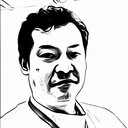Voxel-based clustered imaging by multiparameter diffusion tensor images for glioma grading.
Cuvinte cheie
Abstract
Gliomas are the most common intra-axial primary brain tumour; therefore, predicting glioma grade would influence therapeutic strategies. Although several methods based on single or multiple parameters from diagnostic images exist, a definitive method for pre-operatively determining glioma grade remains unknown. We aimed to develop an unsupervised method using multiple parameters from pre-operative diffusion tensor images for obtaining a clustered image that could enable visual grading of gliomas. Fourteen patients with low-grade gliomas and 19 with high-grade gliomas underwent diffusion tensor imaging and three-dimensional T1-weighted magnetic resonance imaging before tumour resection. Seven features including diffusion-weighted imaging, fractional anisotropy, first eigenvalue, second eigenvalue, third eigenvalue, mean diffusivity and raw T2 signal with no diffusion weighting, were extracted as multiple parameters from diffusion tensor imaging. We developed a two-level clustering approach for a self-organizing map followed by the K-means algorithm to enable unsupervised clustering of a large number of input vectors with the seven features for the whole brain. The vectors were grouped by the self-organizing map as protoclusters, which were classified into the smaller number of clusters by K-means to make a voxel-based diffusion tensor-based clustered image. Furthermore, we also determined if the diffusion tensor-based clustered image was really helpful for predicting pre-operative glioma grade in a supervised manner. The ratio of each class in the diffusion tensor-based clustered images was calculated from the regions of interest manually traced on the diffusion tensor imaging space, and the common logarithmic ratio scales were calculated. We then applied support vector machine as a classifier for distinguishing between low- and high-grade gliomas. Consequently, the sensitivity, specificity, accuracy and area under the curve of receiver operating characteristic curves from the 16-class diffusion tensor-based clustered images that showed the best performance for differentiating high- and low-grade gliomas were 0.848, 0.745, 0.804 and 0.912, respectively. Furthermore, the log-ratio value of each class of the 16-class diffusion tensor-based clustered images was compared between low- and high-grade gliomas, and the log-ratio values of classes 14, 15 and 16 in the high-grade gliomas were significantly higher than those in the low-grade gliomas (p < 0.005, p < 0.001 and p < 0.001, respectively). These classes comprised different patterns of the seven diffusion tensor imaging-based parameters. The results suggest that the multiple diffusion tensor imaging-based parameters from the voxel-based diffusion tensor-based clustered images can help differentiate between low- and high-grade gliomas.


